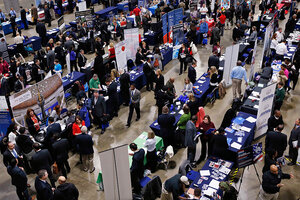US economy adds 175,000 jobs despite hard winter: Is stronger growth ahead?
Unemployment edged up slightly in February to 6.7 percent of the workforce, but the jobs number is a sizable step up from the pace of job creation in the previous two months.

Military personnel, veterans and military spouses attend the Hiring Our Heroes job fair in Washington in this file photo taken January 10, 2014. US job growth rose more than expected in February, which could ease fears of an abrupt slowdown in economic growth and keep the Federal Reserve on track in reducing its monetary stimulus.
Kevin Lamarque/Reuters
Washington
Employers added a solid 175,000 jobs to US payrolls in February despite disruptive winter storms – a hint that the economy may be poised for stronger growth in coming months.
The employment numbers, released by the Labor Department Friday, were a bit stronger than economists had expected and a sizable step up from the pace of job creation in the previous two months. US businesses added 84,000 jobs in December and 129,000 in January.
Unemployment edged up slightly in February to 6.7 percent of the workforce, a sign that there are still many Americans who want to work and aren’t finding jobs. But the overall message from the latest monthly jobs report is positive.
“After several months of weak job numbers, the February gain ... is reassuring [us] that the labor market continues to improve and that economic growth will pick up in the months ahead,” writes John Silvia, chief economist at Wells Fargo, in an analysis of the numbers.
Many forecasters see a combination of reasons why economic growth should pick up at least modestly: recovering consumer health, rising business investment, and fading “drag” from changes in federal taxes and spending enacted over the past year.
Another factor is a likely rebound due to the weather. Cold temperatures plus more than the usual number of show-stopping storms for US cities slowed the economy and business hiring during the winter, but that should translate into some bounce-back as temperatures begin to warm.
Consumer spending should benefit from rising wages and low inflation, Mr. Silvia says. He sees disposable incomes rising 2 percent on average in 2014, on an after-inflation or “real” basis. That’s much better than last year’s 0.7 percent pace, he says.
A wild card for the economy is events overseas, where some emerging-market nations have seen a sharp slowdown in growth and where Russia-Ukraine turmoil carries some threat to a still-weak European economy.
Yet economists generally expect the Federal Reserve to continue to “taper” its monetary stimulus. That means continuing to dial down the scale of monthly bond purchases that are designed to put downward pressure on long-term interest rates.
US stock indexes rose modestly on the Labor Department numbers, from levels that were already around record highs.
Amid the hopes for faster growth ahead, the job market still has a long way to go toward full recovery.
Some 10.5 million Americans are officially unemployed, and about 4 in 10 of those have been out of jobs and looking for work for half a year or more.

